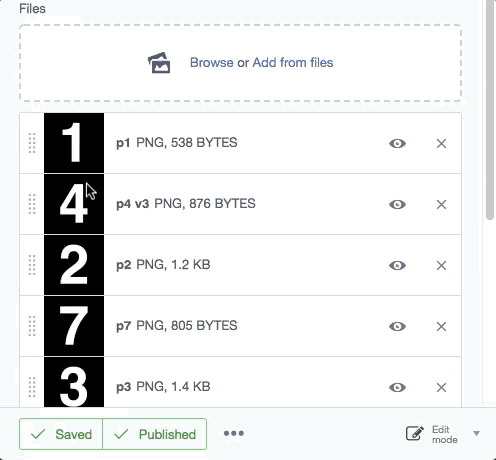dia-nz / sortablefile
An extension for SilverStripe 4 that adds sorting to UploadField.
Installs: 95
Dependents: 0
Suggesters: 0
Security: 0
Stars: 0
Watchers: 0
Forks: 30
Type:silverstripe-vendormodule
pkg:composer/dia-nz/sortablefile
Requires
- silverstripe/asset-admin: ^1.1
- silverstripe/assets: ^1.1
- silverstripe/config: ^1
- silverstripe/framework: ^4.1
Requires (Dev)
- phpunit/phpunit: ^5.7
README
An extension for SilverStripe 4.1+ that allows sorting of files attached via UploadField.
This module decorates the existing UploadField and adds sorting capabilities to it.
This is meant to be used with a many_many relation of Files or Images.
Installation
This module only works with SilverStripe 4.1+.
For a version compatible with SilverStripe 3, please use a 1.x release.
The easiest way is to use composer:
composer require dia-nz/sortablefile ^2.0
Run dev/build afterwards.
Usage
Usage is pretty simple. Just use SortableUploadField instead of UploadField to manage your many_many relations.
To persist the sort-order, an additional extra-field with the sort-order has to be added to the many_many relation.
You can do so by specifying the sort column via many_many_extraFields (see example below).
By default the SortableUploadField assumes that the sort-column is named SortOrder. If you want to use another
field-name (for example Sort), you have to explicitly set it:
SortableUploadField::create('Files')->setSortColumn('Sort');
Example setup for many_many
Let's assume we have a PortfolioPage that has multiple Images attached.
The PortfolioPage looks like this:
use SilverStripe\Assets\Image; use SilverStripe\Forms\FieldList; use Bummzack\SortableFile\Forms\SortableUploadField; class PortfolioPage extends Page { // This page can have many images private static $many_many = [ 'Images' => Image::class ]; // this adds the SortOrder field to the relation table. // Please note that the key (in this case 'Images') // has to be the same key as in the $many_many definition! private static $many_many_extraFields = [ 'Images' => ['SortOrder' => 'Int'] ]; public function getCMSFields() { $this->beforeUpdateCMSFields(function (FieldList $fields) { $fields->addFieldToTab('Root.Main', SortableUploadField::create( 'Images', $this->fieldLabel('Images') )); }); return parent::getCMSFields(); } }
Once this has been set up like described above, then you should be able to add images in the CMS and sort them by dragging them (use the handle on the left).
Templates
Sorting the Files via a relation table isn't easily achievable via a DataExtension. This is why it's currently up to the user to implement a getter that will return the sorted files, something along the lines of:
// Use this in your templates to get the correctly sorted images public function SortedImages() { return $this->Images()->Sort('SortOrder'); }
And then in your templates use:
<% loop $SortedImages %>
$ScaleWidth(500)
<% end_loop %>
Alternatively, you could simply use the sort statement in your template, which will remove the need for a special getter method in your page class.
<% loop $Images.Sort('SortOrder') %>
$ScaleWidth(500)
<% end_loop %>
Many Many Through
The module supports editing many many through lists as well. The advantage of using many_many through is, that your relations can be versioned properly.
Example Setup
Here's an example setup with the same PortfolioPage as above, but now using many_many through instead. If this seems unclear, please also consult the official documentation.
First, the PortfolioPage class:
<?php use Bummzack\SortableFile\Forms\SortableUploadField; use SilverStripe\Forms\FieldList; class PortfolioPage extends Page { private static $many_many = [ 'Images' => [ 'through' => PortfolioImage::class, 'from' => 'PortfolioPage', 'to' => 'Image', ] ]; // This is required to automatically publish your images // whenever you publish your page private static $owns = [ 'Images' ]; // This is required to publish deletions as well, // as this will not happen by default! private static $cascade_deletes = [ 'Images' ]; public function getCMSFields() { $this->beforeUpdateCMSFields(function (FieldList $fields) { $fields->addFieldToTab('Root.Main', SortableUploadField::create( 'Images', $this->fieldLabel('Images') )); }); return parent::getCMSFields(); } // This is a helper method, that is needed to display the items in the // correct order. Is required for proper CMS functionality and can be // used in templates as $getImages public function getImages() { return $this->Images()->sort('SortOrder'); } }
The idea of the many_many through relation is, that you have an intermediate DataObject, that connects your objects. So we add a DataObject named PortfolioImage:
<?php use SilverStripe\Assets\Image; use SilverStripe\ORM\DataObject; use SilverStripe\Versioned\Versioned; class PortfolioImage extends DataObject { private static $db = [ 'SortOrder' => 'Int' ]; private static $has_one = [ 'Image' => Image::class, 'PortfolioPage' => PortfolioPage::class ]; private static $default_sort = 'SortOrder'; // It's important that you add the Versioned extension to this! private static $extensions = [ Versioned::class ]; }
We should also add the belongs_many_many relation to the Image class. This is very easy to do via config. So in your mysite/_config/config.yml add:
SilverStripe\Assets\Image: belongs_many_many: PortfolioPages: PortfolioPage.Images
What happened to has_many support?
Support for has_many relations has been dropped, since it can lead to a very bad user experience if a file can only be added to a single page.
Imagine a user added an image to Page A, then adds the same image via Add from files to Page B.
The file would then be removed from Page A, without any warning or explanation, which is bad UX.

